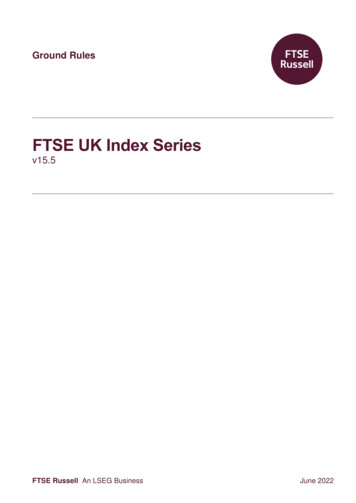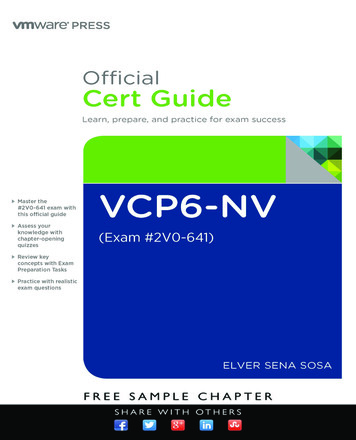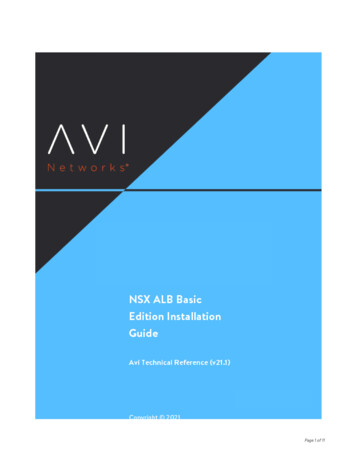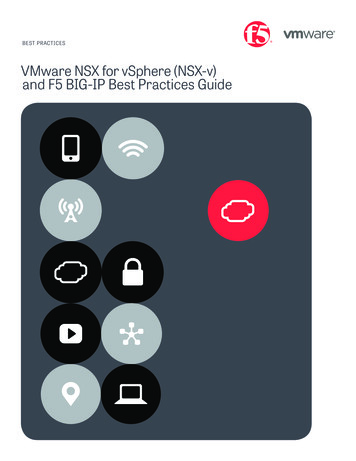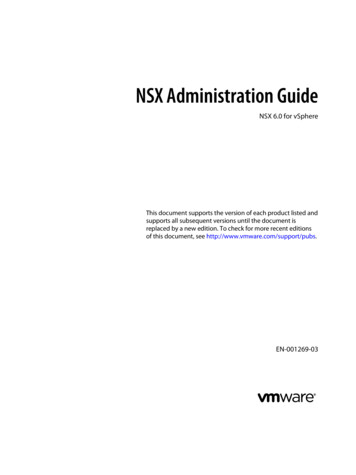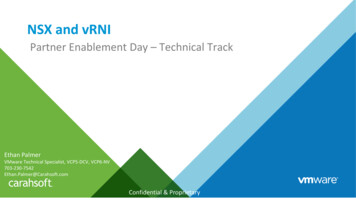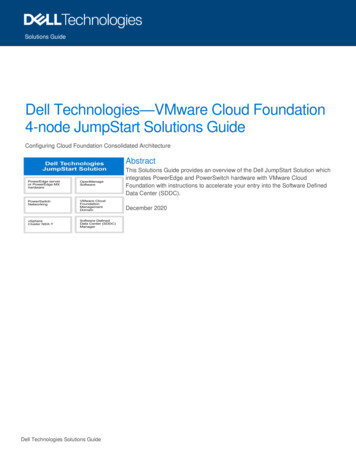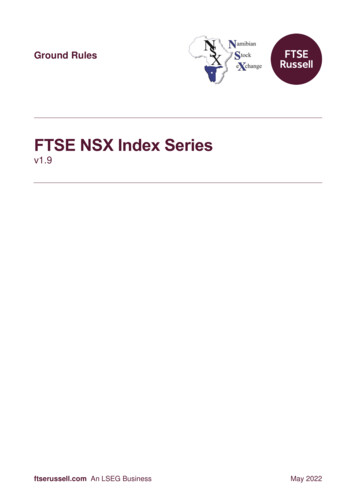
Transcription
Ground RulesFTSE NSX Index Seriesv1.9ftserussell.com An LSEG BusinessMay 2022
Contents1.0Introduction . 32.0Management Responsibilities. 53.0FTSE Russell Index Policies . 74.0Eligible Securities . 95.0Periodic Review of Constituent Companies . 106.0Changes to Constituent Companies . 117.0Corporate Actions and Events. 128.0Industry Classification Benchmark . 139.0Index Calculation . 14Appendix A: Index Opening and Closing Hours . 15Appendix B: Status of Indices . 16Appendix C: Capping Methodology . 17Appendix D: Further Information . 19FTSE Russell An LSEG Business FTSE NSX Index Series, v1.9, May 20222 of 19
Section 1Introduction1.0Introduction1.1This document sets out the Ground Rules for the construction and management of the FTSE NSXIndex Series. Copies of the Ground Rules are available from FTSE Russell.1.2The FTSE NSX Index Series is designed to represent the performance of Namibian companies,providing investors with a comprehensive and complementary set of indices which measure theperformance of the major capital and industry segments of the Namibian market.1.3The FTSE NSX Index Series does not take account of ESG factors in its index design.1.4FTSE RussellFTSE Russell is a trading name of FTSE International Limited, Frank Russell Company, FTSEGlobal Debt Capital Markets Limited (and its subsidiaries FTSE Global Debt Capital Markets Inc.and FTSE Fixed Income Europe Limited), FTSE Fixed Income LLC, The Yield Book Inc and BeyondRatings.1.5The FTSE NSX Index Series is made up of the following indices: FTSE NSX Overall Index FTSE NSX Overall Sector Indices (21 sectors) FTSE NSX Local Index FTSE NSX Capped Overall IndexCompanies in the index will be capped at 10% on a quarterly basis.1.6The FTSE NSX Index Series is calculated in NAD. Price and Total Return versions will be calculatedfor each Index. Price Indices are calculated in real-time. Total Return indices are calculated at theend of each working day. The Total Return Indices include income based on ex dividendadjustments.1.7FTSE NSX Capped Overall Index will be provided in NAD on an end of day basis.1.8FTSE Russell hereby notifies users of the index series that it is possible that circumstances,including external events beyond the control of FTSE Russell, may necessitate changes to, or thecessation of, the index series and therefore, any financial contracts or other financial instrumentsthat reference the index series or investment funds which use the index series to measure theirperformance should be able to withstand, or otherwise address the possibility of changes to, orcessation of, the index series.FTSE Russell An LSEG Business FTSE NSX Index Series, v1.9, May 20223 of 19
1.9Index users who choose to follow this index or to buy products that claim to follow this index shouldassess the merits of the index’s rules-based methodology and take independent investment advicebefore investing their own or client funds. No liability whether as a result of negligence or otherwiseis accepted by FTSE Russell or JSE for any losses, damages, claims and expenses suffered by anyperson as a result of: any reliance on these Ground Rules, and/orany errors or inaccuracies in these Ground Rules, and/orany non-application or misapplication of the policies or procedures described in these GroundRules, and/orany errors or inaccuracies in the compilation of the Index or any constituent data.FTSE Russell An LSEG Business FTSE NSX Index Series, v1.9, May 20224 of 19
Section 2Management Responsibilities2.0Management Responsibilities2.1FTSE International Limited (FTSE)2.1.1FTSE is the benchmark administrator of the index series.12.1.2FTSE is responsible for the daily calculation, production and operation of the FTSE NSX IndexSeries and will: maintain records of the index weightings of all constituents; make changes to the constituents and their weightings in accordance with the Ground Rules; carry out the periodic index reviews of the index and apply the changes resulting from thereviews as required by the Ground Rules; publish changes to the constituent weightings resulting from their ongoing maintenance and theperiodic reviews; disseminate the indices.2.1.3FTSE is also responsible for monitoring the performance of the FTSE NSX Index Series throughoutthe day and will determine whether the status of each index should be Firm, Indicative or Held.2.2Status of these Ground Rules2.2.1These Ground Rules set out the methodology and provide information about the publication of theFTSE NSX Index Series.2.3Amendments to these Ground Rules2.3.1These Ground Rules shall be subject to regular review (at least once a year) by FTSE Russell toensure that they best reflect the aims of the index series. Any proposals for significant amendmentsto these Ground Rules will be subject to consultation with FTSE Russell advisory committees andother stakeholders if appropriate. The feedback from these consultations will be considered by theFTSE Russell Index Governance Board before approval is granted.1The term administrator is used in this document in the same sense as it is defined in Regulation (EU) 2016/1011 of the EuropeanParliament and of the Council of 8 June 2016 on indices used as benchmarks in financial instruments and financial contracts or tomeasure the performance of investment funds (the European Benchmark Regulation) and The Benchmarks (Amendment andTransitional Provision) (EU Exit) Regulations 2019 (the UK Benchmark Regulation).FTSE Russell An LSEG Business FTSE NSX Index Series, v1.9, May 20225 of 19
2.3.2As provided for in the Statement of Principles for FTSE Russell Equity Indices, where FTSE Russelldetermines that the Ground Rules are silent or do not specifically and unambiguously apply to thesubject matter of any decision, any decision shall be based as far as practical on the Statement ofPrinciples. After making any such determination, FTSE Russell shall advise the market of itsdecision at the earliest opportunity. Any such treatment will not be considered as an exception orchange to the Ground Rules, or to set a precedent for future action, but FTSE Russell will considerwhether the Rules should subsequently be updated to provide greater clarity.FTSE Russell An LSEG Business FTSE NSX Index Series, v1.9, May 20226 of 19
Section 3FTSE Russell Index Policies3.0FTSE Russell Index PoliciesThese Ground Rules should be read in conjunction with the following policy documents which can beaccessed using the links below:3.1Corporate Actions and Events Guide3.1.1Full details of changes to constituent companies due to corporate actions and events can beaccessed in the Corporate Actions and Events Guide using the following link:Corporate Actions and Events Guide.pdf3.2Statement of Principles for FTSE Russell Equity Indices (the Statement of Principles)3.2.1Indices need to keep abreast of changing markets and the Ground Rules cannot anticipate everyeventuality. Where the Rules do not fully cover a specific event or development, FTSE Russell willdetermine the appropriate treatment by reference to the Statement of Principles which summarisesthe ethos underlying FTSE Russell’s approach to index construction. The Statement of Principles isreviewed annually and any changes proposed by FTSE Russell are presented to the FTSE RussellPolicy Advisory Board for discussion before approval by the FTSE Russell Index Governance Board.The Statement of Principles can be accessed using the following link:Statement of Principles.pdf3.3Queries and Complaints3.3.1FTSE Russell’s complaints procedure can be accessed using the following link:Benchmark Determination Complaints Handling Policy.pdf3.4Index Policy for Trading Halts and Market Closures3.4.1Guidance for the treatment of index changes in the event of trading halts or market closures can befound using the following link:Index Policy for Trading Halts and Market Closures.pdf3.5Index Policy in the Event Clients are Unable to Trade a Market or a Security3.5.1Details of FTSE Russell’s treatment can be accessed using the following link:Index Policy in the Event Clients are Unable to Trade a Market or a Security.pdfFTSE Russell An LSEG Business FTSE NSX Index Series, v1.9, May 20227 of 19
3.6Recalculation Policy and Guidelines3.6.1The FTSE NSX Index Series is recalculated whenever inaccuracies or distortions occur that aredeemed to be significant. Users of the FTSE NSX Index Series are notified through appropriatemedia.For further information please refer to the FTSE Russell Recalculation Policy and Guidelinesdocument which is available from the FTSE Russell website using the link below or by contactinginfo@ftserussell.com.Recalculation Policy and Guidelines Equity Indices.pdf3.7Policy for Benchmark Methodology Changes3.7.1Details of FTSE Russell’s policy for making benchmark methodology changes can be accessedusing the following link:Policy for Benchmark Methodology Changes.pdf3.8FTSE Russell Governance Framework3.8.1To oversee its indices, FTSE Russell employs a governance framework that encompasses product,service and technology governance. The framework incorporates the London Stock ExchangeGroup’s three lines of defence risk management framework and is designed to meet therequirements of the IOSCO Principles for Financial Benchmarks 2, the European benchmarkregulation3 and the UK benchmark regulation4. The FTSE Russell Governance Framework can beaccessed using the following link:FTSE Russell Governance Framework.pdf2IOSCO Principles for Financial Benchmarks Final Report, FR07/13 July 2013Regulation (EU) 2016/1011 of the European Parliament and of the Council of 8 June 2016 on indices used as benchmarks in financialinstruments and financial contracts or to measure the performance of investment funds4The Benchmarks (Amendment and Transitional Provision) (EU Exit) Regulations 20193FTSE Russell An LSEG Business FTSE NSX Index Series, v1.9, May 20228 of 19
Section 4Eligible Securities4.0Eligible Securities4.1FTSE NSX Overall Index4.1.1The universe of eligible constituents for the FTSE NSX Overall Index Series is all the companies thathave a listing on the NSX. Only ordinary shares are considered for index inclusion.4.2The FTSE NSX Local Index4.2.1The universe of eligible constituents is made up of Namibian incorporated securities which have aprimary listing on the NSX.4.3There are no liquidity requirements for entry to the FTSE NSX Index Series.4.4Secondary Lines4.4.1Where there are multiple lines of equity capital in a company, all are included and priced separately,provided that they pass index eligibility screens in their own right. All partly-paid classes of equity are priced on a fully-paid basis if the calls are fixed and arepayable at known future dates. Those where future calls are uncertain in either respect arepriced on a partly-paid basis.4.5Ineligible securities4.5.1Exchange Traded Funds (ETFs) and funds whose prices are a direct derivation of underlyingholdings (e.g. Unit Trusts, Mutual Funds) are not eligible for inclusion.4.5.2Stocks on the Development Capital Board are ineligible for index inclusion.4.6Investability Weightings4.6.1Constituents of the FTSE NSX Index Series are adjusted for free float.Further details on free float restrictions can be accessed using the following link:Free Float Restrictions.pdf4.6.2Initial WeightingFree float is calculated using available published information rounded to 12 decimal places.Companies with a free float of 5% or below are excluded from the index.FTSE Russell An LSEG Business FTSE NSX Index Series, v1.9, May 20229 of 19
Section 5Periodic Review of Constituent Companies5.0Periodic Review of Constituent Companies5.1Review Dates5.1.1The quarterly review of the FTSE NSX Index Series constituents takes place in March, June,September and December. The index constituents will be compiled using data for the purpose ofdetermining full market cap as at the close of business on the Monday four weeks prior to the revieweffective date.5.1.2Any constituent changes will be implemented after the close of business on the third Friday of thereview month (i.e. effective Monday).5.1.3FTSE Russell will be responsible for publishing the outcome of the periodic review.FTSE Russell An LSEG Business FTSE NSX Index Series, v1.9, May 202210 of 19
Section 6Changes to Constituent Companies6.0Changes to Constituent Companies6.1New Issues6.1.1There will be no intra review additions for the FTSE NSX Index Series. If a constituent is added tothe underlying universe it will only be considered for inclusion at the next quarterly review.6.2Deletions and Replacements6.2.1If a constituent is delisted from the Namibian Stock Exchange, ceases to have a firm quotation, issubject to a takeover or has, in the opinion of FTSE Russell, ceased to be a viable constituent asdefined by these rules, it will be removed from the relevant index.FTSE Russell An LSEG Business FTSE NSX Index Series, v1.9, May 202211 of 19
Section 7Corporate Actions and Events7.0Corporate Actions and Events7.1Full details of changes to constituent companies due to corporate actions and events can beaccessed in the Corporate Actions and Events Guide using the following link:Corporate Actions and Events Guide.pdfA Corporate ‘Action’ is an action on shareholders with a prescribed ex date. The share price will besubject to an adjustment on the ex date. These include the following: Capital RepaymentsRights Issues/Entitlement OffersStock ConversionSplits (sub-division) / Reverse splits (consolidation)Scrip issues (Capitalisation or Bonus Issue)A Corporate ‘Event’ is a reaction to company news (event) that may impact the index depending onthe index rules. For example, a company announces a strategic shareholder is offering to sell theirshares (secondary share offer) – this could result in a free float weighting change in the index.Where an index adjustment is required FTSE will provide notice advising of the timing of the change.7.2Shares in Issue7.2.1Changes to the number of shares in issue for constituent securities are covered in the CorporateActions and Events Guide.7.3Investability Weightings7.3.1Changes to free float for constituent securities are covered in the Corporate Actions and EventsGuide.7.4Suspension of Dealing7.4.1Suspension of dealing rules can be found within the Corporate Actions and Events Guide.7.5Takeovers, mergers and demergersThe treatment of takeovers, mergers and demergers can be found within the Corporate Actions andEvents Guide.FTSE Russell An LSEG Business FTSE NSX Index Series, v1.9, May 202212 of 19
Section 8Industry Classification Benchmark8.0Industry Classification Benchmark8.1Classification of Constituents within Industry and Sectors 58.1.1The FTSE NSX Index Series constituents are classified into Industries, Supersectors, Sectors andSubsectors, as defined by the Industry Classification Benchmark (ICB).8.1.2Details of the Industry Classification Benchmark are available from FTSE Russell and published onthe FTSE Russell website (www.ftserussell.com) and can be accessed using the following link:Industry Classification Benchmark5FTSE indices migrated to the new ICB classification system in March 2021.FTSE Russell An LSEG Business FTSE NSX Index Series, v1.9, May 202213 of 19
Section 9Index Calculation9.0Index Calculation9.1Index Algorithm9.1.1All indices within the FTSE NSX Index Series will be displayed to one decimal point.9.1.2The FTSE NSX Index Series is calculated using the following formula:N ( pi si i 1f i ci )dWhere, i 1, 2, , N N is the number of securities in the index. pi is the latest trade price of the component security (or the price at the close of the index on theprevious day). si is the number of shares in issue used by FTSE Russell for the security, as defined in theseGround Rules. fi is the Investability Weighting Factor to be applied to a security to allow amendments to itsweighting, expressed as a number between 0 and 1, where 1 represents a 100% free float. Thisfactor is published by FTSE Russell for each security in the underlying index. ci is the Capping Factor to be applied to a security to correctly weight that security in the index. Thisfactor maps the investable market capitalisation of each stock to a notional market capitalisation forinclusion in the index. d is the divisor, a figure that represents the total issued share capital of the index at the base date.The divisor can be adjusted to allow changes in the issued share capital of individual securities to bemade without distorting the index.FTSE Russell An LSEG Business FTSE NSX Index Series, v1.9, May 202214 of 19
Appendix A: Index Opening and Closing HoursIndexOpenCloseFTSE NSX Index Series09:0017:00Timings are local hours.FTSE Russell An LSEG Business FTSE NSX Index Series, v1.9, May 202215 of 19
Appendix B: Status of IndicesThe FTSE NSX Index Series is calculated in real time.For further details of real time definitions please refer to the following guide:Real Time Status Definitions.pdfThe official opening and closing hours of the FTSE NSX Index Series are set out in Appendix A. Variations tothe official hours of the index will be published by FTSE Russell.FTSE Russell An LSEG Business FTSE NSX Index Series, v1.9, May 202216 of 19
Appendix C: Capping MethodologyCapping Methodology at Quarterly ReviewsCapping will only be applied at the quarterly review and therefore the percentage weight of any constituent inthe index may move above/below the capped level during the quarter due to price changes and corporateactions.1. The calculation of the constituent capping factors (c) will be based on prices at close on the secondFriday of the review month using shares in issue and investability weights as designated to take effectafter close on the third Friday of the review month (i.e. taking effect on the review effective date).2. The calculation will take into account any corporate actions/events that take effect after close on thesecond Friday of the review month up to and including the review effective date if they have beenannounced and confirmed by the second Friday of the review month.3. Corporate actions / events announced after the second Friday of the review month that become effectiveup and including the review effective date will not result in any further adjustment.4. Upon completion of the above steps the capping procedure is applied using the following algorithm:NB. The algorithm is applied to each constituent which requires capping, i.e. any constituent whoseuncapped weight is greater than the capping level (Capping level: 10%).The Constituent Capping Factor ci is given by:ci ZI ( pi si f i ) (pj sj fj)j JWhere, i denotes the security to be capped. j denotes an uncapped security. J is the subset of securities that are uncapped. pk is the official closing price of the kth security. sk is the number of shares in issue of the kth security. fk is the free float factor of the kth security. I is the percentage of the index represented by all uncapped constituents. Z is the percentage capping levelThe constituent capping factor is calculated for all constituents whose uncapped weight after theapplication of investability weightings is greater than the Capping Level. The weights of the capped andFTSE Russell An LSEG Business FTSE NSX Index Series, v1.9, May 202217 of 19
uncapped constituents in the index are then calculated. If following the application of this cappingprocedure other constituents have moved above the Capping Level in weight then the process isrepeated including the new constituent(s) which require capping.FTSE Russell An LSEG Business FTSE NSX Index Series, v1.9, May 202218 of 19
Appendix D: Further InformationA Glossary of Terms used in FTSE Russell’s Ground Rule documents can be found using the following link:Glossary.pdfFurther information on the FTSE NSX Index Series is available from FTSE Russell.For contact details please visit the FTSE Russell website or contact FTSE Russell client services atinfo@ftserussell.com.Website: www.ftserussell.comThe Namibian Stock Exchange can be contacted at info@nsx.com.na. 2022 London Stock Exchange Group plc and its applicable group undertakings (the “LSE Group”). The LSE Group includes (1) FTSEInternational Limited (“FTSE”), (2) Frank Russell Company (“Russell”), (3) FTSE Global Debt Capital Markets Inc. and FTSE GlobalDebt Capital Markets Limited (together, “FTSE Canada”) and (4) FTSE FI Europe Limited (“FTSE FI Europe”), (5) FTSE Fixed IncomeLLC (“FTSE FI”), (6) The Yield Book Inc (“YB”) and (7) Beyond Ratings S.A.S. (“BR”). All rights reserved.The FTSE NSX Index Series is calculated by or on behalf of FTSE International Limited or its affiliate, agent or partner. FTSEInternational Limited is authorised and regulated by the Financial Conduct Authority as a benchmark administrator.FTSE Russell is a trading name of FTSE, Russell, FTSE Canada, FTSE FI Europe, FTSE FI, YB and BR. “FTSE ”, “Russell ”,“FTSE Russell ”, “FTSE4Good ”, “ICB ”, “The Yield Book ”, “Beyond Ratings ” and all other trademarks and service marks usedherein (whether registered or unregistered) are trade marks and/or service marks owned or licensed by the applicable member of theLSE Group or their respective licensors and are owned, or used under licence, by FTSE, Russell, FTSE FI Europe, FTSE Canada,FTSE FI, YB or BR.All information is provided for information purposes only. Every effort is made to ensure that all information given in this publication isaccurate, but no responsibility or liability can be accepted by any member of the LSE Group nor their respective directors, officers,employees, partners or licensors for any errors or for any loss from use of this publication or any of the information or data containedherein.No member of the LSE Group nor their respective directors, officers, employees, partners or licensors make any claim, prediction,warranty or representation whatsoever, expressly or impliedly, either as to the results to be obtained from the use of the FTSE NSXIndex Series or the fitness or suitability of the Index Series for any particular purpose to which it might be put.No member of the LSE Group nor their respective directors, officers, employees, partners or licensors provide investment advice andnothing in this document should be taken as constituting financial or investment advice. No member of the LSE Group nor theirrespective directors, officers, employees, partners or licensors make any representation regarding the advisability of investing in anyasset. A decision to invest in any such asset should not be made in reliance on any information herein. Indices cannot be invested indirectly. Inclusion of an asset in an index is not a recommendation to buy, sell or hold that asset. The general information contained inthis publication should not be acted upon without obtaining specific legal, tax, and investment advice from a licensed professional.No part of this information may be reproduced, stored in a retrieval system or transmitted in any form or by any means, electronic,mechanical, photocopying, recording or otherwise, without prior written permission of the applicable member of the LSE Group. Use anddistribution of the LSE Group index data and the use of their data to create financial products require a licence with FTSE, Russell,FTSE Canada, FTSE FI Europe, FTSE FI, YB, BR and/or their respective licensors.FTSE Russell An LSEG Business FTSE NSX Index Series, v1.9, May 202219 of 19
1.2 The FTSE NSX Index Series is designed to represent the performance of Namibian companies, . 1.3 The FTSE NSX Index Series does not take account of ESG factors in its index design. 1.4 FTSE Russell FTSE Russell is a trading name of FTSE International Limited, Frank Russell Company, FTSE . 3.1 Corporate Actions and Events Guide
